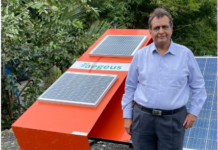
Trains that are never late? To someone like me living in the UK, it may sound impossibly utopian. But Siemens say that thanks to Big Data and analytics it could soon be a reality.
Train operators have responsibility for getting millions of people to where they want to be every day. When journeys are delayed it causes not only disruption to people’s schedules, but operators often face large financial penalties.
Siemens AG is one of the world’s largest providers of railway infrastructure, serving rail operators in over 60 countries. Through harnessing Big Data, sensors and predictive analytics they say they can now guarantee their customers close to 100% reliability.
It calls this the “Internet of Trains” – the on-rails segment of the wider ‘Internet of Things’ concept which describes how everyday objects of all shapes and sizes can now be connected together online and given the ability to communicate and capture data for analytic purposes.
“We are helping our customers to get more value out of their assets,” Gerhard Kreß, director of mobility data services at Siemens, tells me.
“Customers have invested a lot into their assets – trains, rails, signalling – and our task is to help them get better returns.”
Trains are considered a relatively environmentally-friendly form of transport, and with Siemens claiming that their technology improves the efficiency of railways to the point where they are competitive with airlines, this could benefit the planet, too.
Kreß says “Since we introduced one project in Russia last year, we have had just nine delays on rail trips from Moscow to St Petersburg. That’s with 16 trains running multiple journeys each day.
“This means you can rely on the train – if you have to be somewhere at 10.45am you are going to be there at 10.45am – this has made it now extremely hard to get a ticket on those trains because they are always fully booked, so now they are tendering new trains.
“We have seen this in Spain too – a shift away from other types of transport because trains are becoming more reliable. Of course it’s very profitable for rail operators too.”
Sensors on an Internet of Trains system monitor everything from engine temperature, to the open or closed state of doors, to vibrations on the rails, and even image data from outside of the trains using cameras. Machine data on how systems are operating is also used, as are external real-time datasets such as meteorological information.
The data is used to achieve one of three ends. The first is improving asset availability, and this includes the ability to carry out “predictive maintenance” – which means making data-informed decisions about the best time to replace and repair components, ideally before they break and when the equipment would not otherwise be in use.
Secondly, it can be used to increase energy efficiency, which has environmental as well as financial benefits. This includes micro and macro-management – not only can the performance of individual components be monitored to identify sources of inefficiency, but the overall status of a rail network can be monitored to ensure tracks are clear and all trains are where they should be. This means they can travel at optimum speeds without having to worry about what’s in front of them.
The third objective is to improve asset utilization. This basically means the network is transporting as high a volume of passengers and cargo as possible.
“We use data from rail vehicles and the infrastructure. Classically these are complex systems which have their own diagnostic elements so we take everything we can learn from the on-board diagnostics and augment that with sensor data and log file data,” says Kreß.
As well as reliability, very positive results have been achieved in the area of fault-spotting and predictive maintenance.
“In the case of [German national train operator] Deutsche Bahn, we have been monitoring the bearings, the gearboxes, motors and other elements since October and we have not overlooked a single component failure – I am very glad that we managed to pick them all up.”
It is this level of reliability that has allowed Siemens to really put its money where its mouth is, by offering uptime guarantees, meaning they share the risks – as well as the rewards – with the train operators themselves.
Siemens calls its smart rail infrastructure management platform Railigent. It is built on Teradata’s Aster database and analytics, and runs in the AWS cloud. In three years, the team working on dedicated rail service solutions has grown to 70 people with teams based in Germany, Moscow and the US.
Looking to the future, the plan is to make increasing use of visual image data collected from cameras. These can be used to detect changes affecting internal components, such as the speed of wear on brake pads, as well as external factors affecting the train’s performance, such as the condition of overhead wires and tracks.
Kreß tells me “This is increasingly becoming a viable option and is something we will certainly be doing more of.
“The interesting part is when you connect all of this data together to get the ‘digital twin’ – a full view of the infrastructure right down to the condition of the different components. That’s something we are working on and are building step-by-step.”
By: Bernard Marr
Source: www.forbes.com


















